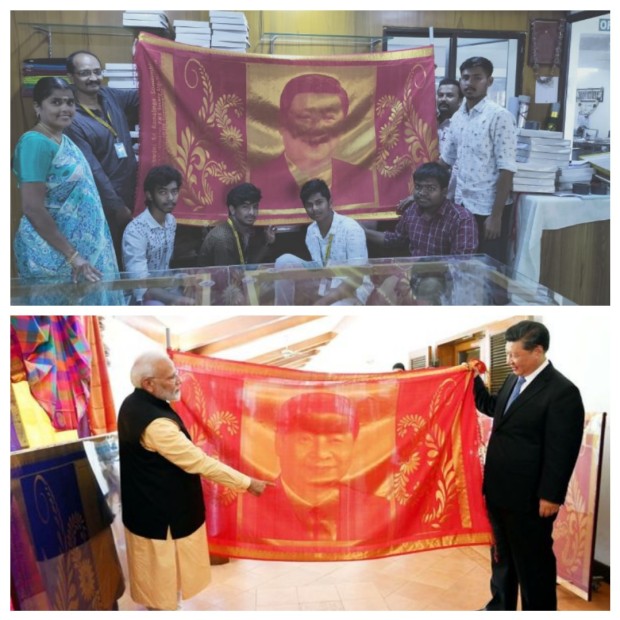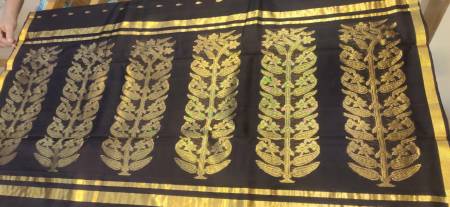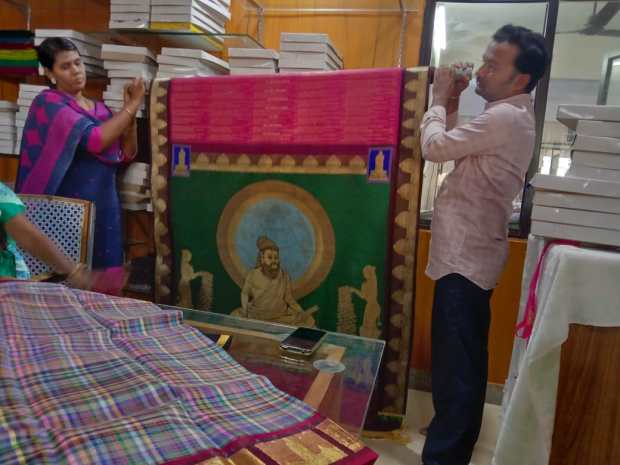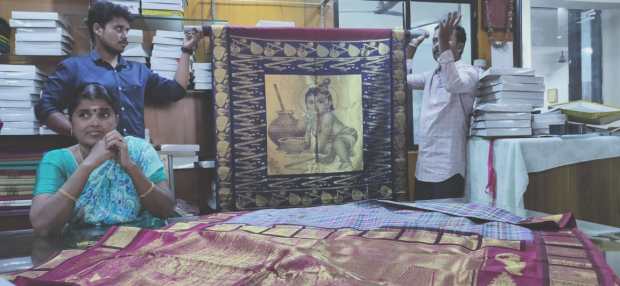
October 12, Prime Minister Narendra Modi gifted a handmade silk shawl made by weavers of a Coimbatore, Sirumugi SRS society to Chinese President Xi Jinping on the concluding day of their two-day informal summit.
Such a beautiful shawl, with an embossment of the image of Xi in gold, which are zari embellishments on bright red silk background was displayed in every National and International media. This news triggered our interest in Sri Ramalinga Sowdambgai Handloom Weaved Cooperative Society,(SRS) Sirumugai. Our interest got fueled even more when we heard that the shawl was handmade.
Readers Club of SNS CE decided to interview the Weavers of Sirumugai, (50 kilometers from our College). We made contact with V Ravikumar, President of Sri Ramalinga Sowdambgai Handloom Weaved Cooperative Society, who immediately agreed to our request for an interview and made all necessary arrangements.(Thanks to Mr.Navin(III year CSE for the contact help)
23, November we made our visit to SRS society (Five Students and Staff). We were welcomed with warmth and love by the entire society. Ms. N.Visalakshi (23-year experience) the Manager of the Society took us to their office; which was looking more of an MNC style office with AC and specialized lights to display the sarees. She gave us a little crash course about the weaver’s society scheme which was initiated by the Government of India after the year 1973 and how Weavers benefit from the Mahatma Gandhi Bunkar Bima Yojana (MGBBY) scheme, also from other Government schemes of Banking, Pension, and Insurance. http://handlooms.nic.in/writereaddata/1236.pdf
In the meantime Manoj Kumar (Designer) and Vishnu Das joined us, they threw light on various aspects of the production and designing involved in making the sarees in Handloom.
The motion of the handloom is operated by skillful human hands, without using any source of energy like electricity, water, air or sun to drive the motion of the loom. Fabric is woven on a handloom by the interlacing of warp, running length-wise and weft or filling, running width-wise. The design of the image is first made in a computer, then punching cards are designed accordingly (binary system) after that they are feed-in Loom Jacquard Machine and then the weaving process consists of pulling the shuttle between the raised warp threads. The weft thread is packed into the cloth using a series of vertical strings called the beater
SRS society innovation in Handloom had started very early, one of the first of its kind was Kodalikarupu Saree (1991), the design was introduced which was produced from a 240 hooks jacquard. This black beauty saree design was from a statue in a temple at Kodalikarupu Village, Thanjavur. To date the regular purchase is going on it is made up of Cora cotton and its price comes around Rs.25,000.

Mayilthokai saree – a silk saree can have 50 colors but this saree consists of od 1,64,492 colors in it. Chief Minister Kalingar was impressed by the design and named it Mayilthokai saree(Peacock Saree). It took them two months to make it.
Thirukural Saree – 1330 couplets in one saree along with Thiruvalluvar statue in it was an unbelievable sight for us. We were almost holding our breath as how can this be done but that was the genius of who they were. The design was so minute that they had written down all the couplets with names, numbers.

They presented a Krishna Saree which had a rare design where the eye of krishana will look at you doesn’t matter which direction you look, this is a rare Indian art phenomenon which is still in some temple paintings done thousands of years before. This is the first time we are seeing this in handloom weaving.

The much-awaited Chinese President Shawl came. Prime Minister’s office had requested them to make it in less than 15 days. Mr.Dharmaraj(Designer)said that normally to weave a face, it may take above a month’s time still they took it as a challenge and started working on it. The design was composed within five days on computer. Mr.Shanmugam and Mr.Manoj the Weavers worked on tight shifts continuously for seven days to achieve this remarkable artistic shawl. The colors of red and yellow were taken from the Chinese flag. Out of various gifts given to the Chinese President Xi Jinping during the informal summit, this was personally unfurled by our PM Mr.Modi which took Chinese President by surprise. At that moment the Sirumugai Weaver’s Team (SRS) had no bounds to their joy to see their art being viewed and appreciated by the entire world.
After the global coverage of the handlooms of Sirumugai, the Weavers of the town have collectively set a target of Rs100 crore this year. Already orders from various parts of Tamilnadu and North India are making them busy all day.
This entire experience was new to the boys as no one had ever visited a handloom center. Mr.Prashanth made a quick rapport with them as he was fluent in Kanada language which was used in Sirumugai. Students got amazed to see how the mathematical knowledge is needed to design the sarees that too they are mostly made up mentally by the Designers.
Mr.Saran and Team were very meticulous in taking notes, pictures and asking for clarifications for every minute details discussed in the interview.
All the weavers were proud to pursue their passion for handlooms. At the same time when we asked if their children are involved in the profession, the answer was always a ‘no’. Handmade products are widely appreciated all over the world in particular in European nations. India once had the world’s best and versatile fabrics in textiles which were systematically destroyed by the invaders. Now it’s time to repair the damage and please note that handloom is organic material which is need of the hour.
https://www.youtube.com/watch?v=sXP8Vkb7-N0
Our request to all, to bring back handloom to a full bloom
- Make sure at least 10% of our wardrobe is Indian handloom.
- Wear them at least for cultural festivals and visits to holy shrines.
- Proudly wear your handloom materials in social media and promote them.
- Buy directly from the weavers and society which would be cost-effective.
On a personal note, this was a nostalgic moment for me. Being born in a Family of Handloom Weavers, I never learned the art of weaving, as I was interested in various other fields. I used to jokingly say from Paruthi Nool I shifted to Pada Nool (Nool means thread and also book in Tamil) Once my entire Town (Nagercoil) was filled with weavers and sound of the Thari(loom) as background music to our lives, now we hardly can hear it. Power loom took over handloom since then the weavers never saw the light of the day. This ray of light in Sirumugai is a delight in my mind. – R.N.Raja Ravi Shankar, AP/English
Readers Club Interview Team – N.Ramasubramanian N (CSE),Saran.S. (CSE),Vinotkumar .N (CSE),Prasanth.R(ECE), Sugeshwaran E (IT)
Readers Club Coordinator – R.N.Raja Ravi Shankar, AP/English



